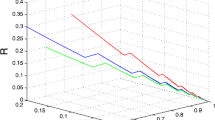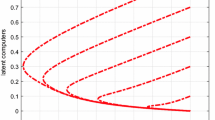Abstract
The dominating majority of previous computer virus epidemic models assume a bilinear infection rate. This assumption, however, ignores the fact that, due to reasons such as overcrowded infected nodes and active protection measures taken at a high level of viral prevalence, the infection rate typically rises in a nonlinear fashion. This paper is devoted to understanding the impact of nonlinear infection rate on the propagation of computer infections. For that purpose, a new computer virus epidemic model is proposed by introducing a generic nonlinear infection rate into a traditional SLBS model. Theoretical analysis shows that, under moderate conditions, the proposed model admits a (viral) globally asymptotically stable equilibrium, fully demonstrating the robustness of stability of the equilibrium to the details of infections. The new model is justified through simulation experiments. We also determine the influence of some model parameters on the viral equilibrium. Our results extend some previously known results.







Similar content being viewed by others
References
Szor, P.: The Art of Computer Virus Research and Defense. Addison-Wesley Education Publishers Inc., Reading (2005)
Cohen, F.: Computer viruses: theory and experiments. Comput. Secur. 6(1), 22–35 (1987)
Murray, W.H.: The application of epidemiology to computer viruses. Comput. Secur. 7(2), 130–150 (1988)
Kephart, J.O., White, S.R.: Directed-graph epidemiological models of computer viruses. In: Proc. 1991 IEEE Comput. Soc. Symp. Res. Secur. Privacy, pp. 343–359 (1991)
Kephart, J.O., White, S.R.: Measuring and modeling computer virus prevalence. In: Proc. 1993 IEEE Comput. Soc. Symp. Res. Secur. Privacy, pp. 2–15 (1993)
Muroya, Y., Enatsu, Y., Li, H.: Global stability of a delayed SIRS computer virus propagation model. Int. J. Comput. Math. 91(3), 347–367 (2014)
Mishra, B.K., Pandey, S.K.: Dynamic model of worms with vertical transmission in computer network. Appl. Math. Comput. 217(21), 8438–8446 (2011)
Zhu, Q., Yang, X., Yang, L.-X., Zhang, X.: A mixing propagation model of computer viruses and countermeasures. Nonlinear Dyn. 73(3), 1433–1441 (2013)
Mishra, B.K., Saini, D.K.: SEIRS epidemic model with delay for transmission of malicious objects in computer network. Appl. Math. Comput. 188(2), 1476–1482 (2007)
Feng, L., Liao, X., Li, H., Han, Q.: Hopf bifurcation analysis of a delayed viral infection model in computer networks. Math. Comput. Model. 56(7–8), 167–179 (2012)
Zhang, C., Zhao, Y., Wu, Y., Deng, S.: A stochastic dynamic model of computer viruses. Discrete Dyn. Nat. Soc. (2012). Article ID 264874
Pastor-Satorras, R., Vespignani, A.: Epidemic spreading in scale-free networks. Phys. Rev. Lett. 86(14), 3200–3203 (2001)
Pastor-Satorras, R., Vespignani, A.: Epidemic dynamics and endemic states in complex networks. Phys. Rev. E 63(6) (2001). Article ID 066117
Huang, C.-Y., Lee, C.-L., Wen, T.-H., Sun, C.-T.: A computer virus spreading model based on resource limitations and interaction costs. J. Syst. Softw. 86(3), 801–808 (2013)
Yang, L.-X., Yang, X., Wen, L., Liu, J.: A novel computer virus propagation model and its dynamics. Int. J. Comput. Math. 89(17), 2307–2314 (2012)
Yang, L.-X., Yang, X.: The spread of computer viruses under the influence of removable storage devices. Appl. Math. Comput. 219(8), 3914–3922 (2012)
Yang, M., Zhang, Z., Li, Q., Zhang, G.: An SLBRS model with vertical transmission of computer virus over Internet. Discrete Dyn. Nat. Soc. (2012). Article ID 693695
Yang, L.-X., Yang, X., Zhu, Q., Wen, L.: A computer virus model with graded cure rates. Nonlinear Anal. RWA 14(1), 414–422 (2013)
Zhang, C., Liu, W., Xiao, J., Zhao, Y.: Hopf bifurcation of an improved SLBS model under the influence of latent period. Math. Probl. Eng. 2013 (2013). Article ID 196214
Muroya, Y., Li, H., Kuniya, T.: On global stability of a nonresident computer virus model. Acta Math. Sci. 19(6), 1935–1944 (2014)
Yang, L.-X., Yang, X., Wen, L., Liu, J.: Propagation behavior of virus codes in the situation that infected computers are connected to the Internet with positive probability, Discrete Dyn. Nat. Soc. (2012). Article ID 693695
Yang, L.-X., Yang, X.: A new epidemic model of computer viruses. Commun. Nonlinear Sci. Numer. Simul. 19(6), 1935–1944 (2014)
Capasso, V.: Mathematical Structures of Epidemic Systems. Lecture Notes in Biomathematics, vol. 97. Springer, Berlin (1993)
Levin, S.A., Hallam, T.G., Gross, L.J.: Applied Mathematical Ecology. Springer, New York (1989)
Anderson, R.M., May, R.M.: Infectious Diseases of Humans: Dynamics and Control. Oxford University Press, Oxford (1991)
Capasso, V., Serio, G.: A generalization of the Kermack-McKendrick deterministic epidemic model. Math. Biosci. 42(1–2), 43–61 (1978)
Korobeinikov, A.: Global properties of infectious disease models with nonlinear incidence. Bull. Math. Biol. 69(6), 1871–1886 (2007)
Korobeinikov, A.: Lyapunov functions and global stability for SIR and SIRS epidemiological models with non-linear transmission. Bull. Math. Biol. 68(3), 615–626 (2006)
Liu, W.M., Levin, S.A., Iwasa, Y.: Influence of nonlinear incidence rates upon the behavior of SIRS epidemiological models. J. Math. Biol. 23(2), 187–204 (1986)
Liu, W.M., Hethcote, H.W., Levin, S.A.: Dynamical behavior of epidemiological models with nonlinear incidence rates. J. Math. Biol. 25(4), 359–380 (1987)
Hethcote, H.W., van den Driessche, P.: Some epidemiological models with nonlinear incidence. J. Math. Biol. 29(3), 271–287 (1991)
Derrick, W.R., van den Driessche, P.: Homoclinic orbits in a disease transmission model with nonlinear incidence and nonconstant population. Discrete Contin. Dyn. Syst. B 2, 299–309 (2003)
Hethcote, H.W., Levin, S.A.: Periodicity in epidemiological models, in Applied Mathematical Ecology (Trieste, 1986), Biomathematics 18. Springer, Berlin, pp. 193–211 (1989)
Ruan, S., Wang, W.: Dynamical behavior of an epidemic model with a nonlinear incidence rate. J. Differ. Equ. 188(1), 135–163 (2003)
Xiao, D., Ruan, S.: Global analysis of an epidemic model with nonmonotone incidence rate. Math. Biosci. 208(2), 419–429 (2007)
Tang, Y., Huang, D., Ruan, S., Zhang, W.: Coexistence of limit cycles and homoclinic loops in a SIRS model with a nonlinear incidence rate. SIAM J. Appl. Math. 69(2), 621–639 (2008)
Li, G., Wang, W.: Bifurcation analysis of an epidemic model with nonlinear incidence. Appl. Math. Comput. 214(2), 411–423 (2009)
Yuan, H., Guan, L., Guan, C.: On modeling the crowding and psychological effects in network-virus prevalence with nonlinear epidemic model. Appl. Math. Comput. 219, 2387–2397 (2012)
Gan, C., Yang, X., Liu, W., Zhu, Q., Zhang, X.: An epidemic model of computer viruses with vaccination and generalized nonlinear incidence rate. Appl. Math. Comput. 222, 265–274 (2013)
Thieme, H.R.: Convergence results and a Poincare–Bendixson trichotomy for asymptotically autonomous differential equations. J. Math. Biol. 30(7), 755–763 (1992)
Robinson, R.C.: An Introduction to Dynamical Systems: Continuous and Discrete. Prentice Hall, Englewood Cliffs (2004)
http://anti-virus-software-review.toptenreviews.com/how-infected-are-we.html
http://pcedu.pconline.com.cn/pingce/pingcesystem/1109/2527365_all.html
Acknowledgments
The authors are grateful to the anonymous reviewers for their valuable comments and suggestions that have greatly improved the quality of this paper. This work is supported by Natural Science Foundation of China (Grant No. 61379158), Science and Technology Support Program of China (Grant No. 2014BAH25F01), and Basic and Advanced Research Program of Chongqing (Grant No. cstc2014jcyjA40054).
Author information
Authors and Affiliations
Corresponding author
Rights and permissions
About this article
Cite this article
Yang, LX., Yang, X. The impact of nonlinear infection rate on the spread of computer virus. Nonlinear Dyn 82, 85–95 (2015). https://doi.org/10.1007/s11071-015-2140-z
Received:
Accepted:
Published:
Issue Date:
DOI: https://doi.org/10.1007/s11071-015-2140-z
Keywords
- Computer virus propagation model
- Nonlinear infection rate
- Saturation effect
- Viral equilibrium
- Global stability
- Asymptotically autonomous system
- Generalized Poincare–Bendixson theorem




